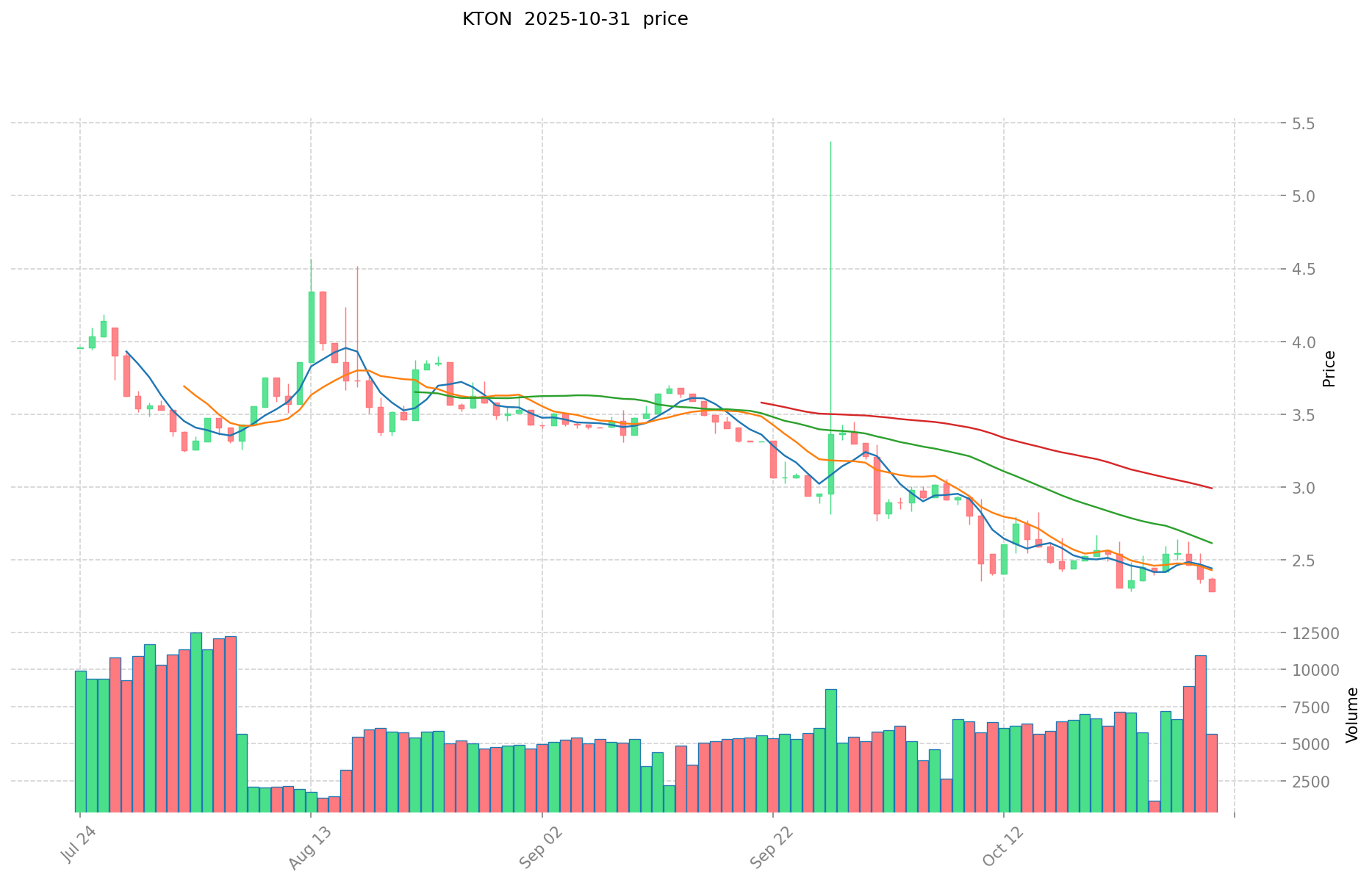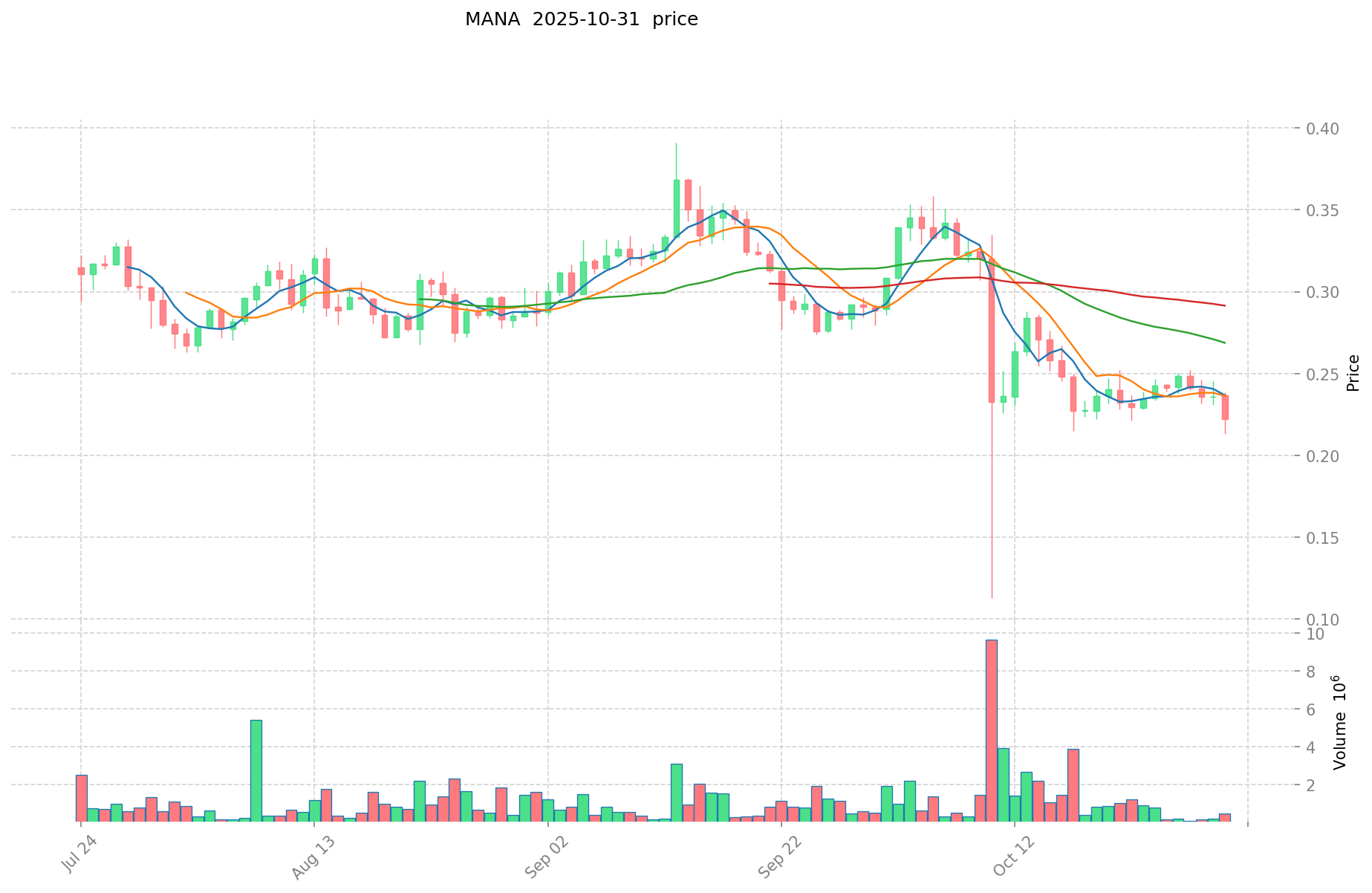KTON vs MANA: A Comparative Analysis of Two Cryptocurrency Tokens in the Metaverse Economy
Introduction: Investment Comparison of KTON vs MANA
In the cryptocurrency market, the comparison between KTON vs MANA has always been an unavoidable topic for investors. The two not only show significant differences in market cap ranking, application scenarios, and price performance, but also represent different positioning in the crypto asset space.
KTON (KTON): Since its launch, it has gained market recognition for its role as a commitment token in the Darwinia Network ecosystem.
MANA (MANA): Launched in 2017, it has been hailed as a virtual world platform token, and is one of the most well-known cryptocurrencies in the metaverse sector.
This article will provide a comprehensive analysis of the investment value comparison between KTON vs MANA, focusing on historical price trends, supply mechanisms, institutional adoption, technological ecosystems, and future predictions, attempting to answer the question that concerns investors the most:
"Which is the better buy right now?"
I. Price History Comparison and Current Market Status
KTON and MANA Historical Price Trends
- 2020: MANA price surged due to the launch of Decentraland's virtual world, reaching an all-time high of $5.85.
- 2021: KTON experienced volatility as the Darwinia Network continued development, with price fluctuations between $1.71 and $416.09.
- Comparative analysis: During the 2021 bull market, MANA rose from $0.08 to $5.85, while KTON showed less dramatic but still significant price movements.
Current Market Situation (2025-10-31)
- KTON current price: $2.318
- MANA current price: $0.2237
- 24-hour trading volume: KTON $12,549 vs MANA $106,007
- Market Sentiment Index (Fear & Greed Index): 29 (Fear)
Click to view real-time prices:
- Check KTON current price Market Price
- Check MANA current price Market Price


II. Core Factors Affecting KTON vs MANA Investment Value
Supply Mechanisms Comparison (Tokenomics)
- MANA: Based on available information, MANA operates on the Solana blockchain as a meme coin that combines meme culture with decentralized finance principles.
- 📌 Historical Pattern: Supply mechanisms typically drive price cycles through scarcity dynamics and distribution models.
Institutional Adoption and Market Applications
- Institutional Holdings: Insufficient information to determine institutional preference between these tokens.
- Enterprise Adoption: Limited data available on enterprise use cases for either token.
- Regulatory Attitudes: No specific regulatory information provided for either token.
Technical Development and Ecosystem Building
- MANA Technical Development: MANA is described as a meme token with decentralized finance principles launched by "terminal of truths" on the Solana blockchain.
- Ecosystem Comparison: Insufficient information to make a detailed ecosystem comparison.
Macroeconomic Factors and Market Cycles
- Investment Value Considerations: According to sources, evaluating MANA's investment potential requires considering overall cryptocurrency market trends, project fundamentals, whether current market capitalization is overvalued, and if the current price point presents a good entry position.
III. 2025-2030 Price Prediction: KTON vs MANA
Short-term Prediction (2025)
- KTON: Conservative $1.209 - $2.325 | Optimistic $2.325 - $3.162
- MANA: Conservative $0.151286 - $0.2258 | Optimistic $0.2258 - $0.257412
Mid-term Prediction (2027)
- KTON may enter a growth phase, with an estimated price range of $1.8518625 - $4.290148125
- MANA may enter a growth phase, with an estimated price range of $0.200049768 - $0.431991528
- Key drivers: Institutional capital inflow, ETFs, ecosystem development
Long-term Prediction (2030)
- KTON: Base scenario $2.464610386706015 - $4.323877871414062 | Optimistic scenario $4.323877871414062 - $5.793996347694843
- MANA: Base scenario $0.28570114140282 - $0.5194566207324 | Optimistic scenario $0.5194566207324 - $0.59737511384226
Disclaimer: The above predictions are based on historical data and market analysis. Cryptocurrency markets are highly volatile and subject to various factors. These projections should not be considered as financial advice. Always conduct your own research before making investment decisions.
KTON:
| 年份 | 预测最高价 | 预测平均价格 | 预测最低价 | 涨跌幅 |
|---|---|---|---|---|
| 2025 | 3.162 | 2.325 | 1.209 | 0 |
| 2026 | 3.429375 | 2.7435 | 2.551455 | 18 |
| 2027 | 4.290148125 | 3.0864375 | 1.8518625 | 33 |
| 2028 | 4.831663584375 | 3.6882928125 | 3.282580603125 | 59 |
| 2029 | 4.387777544390625 | 4.2599781984375 | 4.00437950653125 | 83 |
| 2030 | 5.793996347694843 | 4.323877871414062 | 2.464610386706015 | 86 |
MANA:
| 年份 | 预测最高价 | 预测平均价格 | 预测最低价 | 涨跌幅 |
|---|---|---|---|---|
| 2025 | 0.257412 | 0.2258 | 0.151286 | 0 |
| 2026 | 0.3382484 | 0.241606 | 0.22469358 | 8 |
| 2027 | 0.431991528 | 0.2899272 | 0.200049768 | 29 |
| 2028 | 0.52700067144 | 0.360959364 | 0.3248634276 | 61 |
| 2029 | 0.5949332237448 | 0.44398001772 | 0.3063462122268 | 98 |
| 2030 | 0.59737511384226 | 0.5194566207324 | 0.28570114140282 | 132 |
IV. Investment Strategy Comparison: KTON vs MANA
Long-term vs Short-term Investment Strategies
- KTON: Suitable for investors focusing on ecosystem potential and commitment mechanisms
- MANA: Suitable for investors interested in metaverse and virtual world applications
Risk Management and Asset Allocation
- Conservative investors: KTON: 30% vs MANA: 70%
- Aggressive investors: KTON: 60% vs MANA: 40%
- Hedging tools: Stablecoin allocation, options, cross-currency portfolio
V. Potential Risk Comparison
Market Risk
- KTON: Volatility due to smaller market cap and lower trading volume
- MANA: Exposure to metaverse market trends and potential bubbles
Technical Risk
- KTON: Scalability, network stability
- MANA: Platform security, smart contract vulnerabilities
Regulatory Risk
- Global regulatory policies may have different impacts on both tokens
VI. Conclusion: Which Is the Better Buy?
📌 Investment Value Summary:
- KTON advantages: Commitment token in Darwinia Network, potential for ecosystem growth
- MANA advantages: Established metaverse platform, higher liquidity and market recognition
✅ Investment Advice:
- New investors: Consider MANA for its higher liquidity and established market presence
- Experienced investors: Diversify between KTON and MANA based on risk tolerance
- Institutional investors: Conduct thorough due diligence on both projects' fundamentals
⚠️ Risk Warning: The cryptocurrency market is highly volatile, and this article does not constitute investment advice. None
VII. FAQ
Q1: What are the main differences between KTON and MANA? A: KTON is a commitment token in the Darwinia Network ecosystem, while MANA is a well-known cryptocurrency in the metaverse sector, associated with the Decentraland virtual world platform.
Q2: Which token has shown better historical price performance? A: Based on the available data, MANA has shown more significant price movements, particularly during the 2021 bull market when it rose from $0.08 to $5.85. KTON has experienced volatility but with less dramatic price changes.
Q3: How do the current prices and trading volumes of KTON and MANA compare? A: As of 2025-10-31, KTON's price is $2.318 with a 24-hour trading volume of $12,549, while MANA's price is $0.2237 with a 24-hour trading volume of $106,007. MANA has a significantly higher trading volume.
Q4: What are the long-term price predictions for KTON and MANA? A: For 2030, KTON's base scenario price range is predicted to be $2.46 - $4.32, with an optimistic scenario of $4.32 - $5.79. MANA's base scenario range is $0.29 - $0.52, with an optimistic scenario of $0.52 - $0.60.
Q5: How should investors allocate their assets between KTON and MANA? A: Conservative investors might consider allocating 30% to KTON and 70% to MANA, while aggressive investors might opt for 60% KTON and 40% MANA. However, individual allocations should be based on personal risk tolerance and investment goals.
Q6: What are the main risks associated with investing in KTON and MANA? A: KTON faces risks related to its smaller market cap and lower trading volume, while MANA is exposed to metaverse market trends and potential bubbles. Both tokens are subject to technical risks such as network stability and smart contract vulnerabilities, as well as regulatory risks.
Share
Content